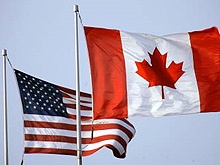 While the U.S. gross domestic product did not meet market expectations for growth at a rate of 3.5% and showed only 3.2% compared with the previous quarter on an annualized basis, the report itself contains mixed data - both favorable and not. First, as we mentioned above, consumption grew by 4,4%. This, undoubtedly, the highest growth rate in this cycle recovery / recovery, which at full two percentage points higher than the previous best indicator of 2,4% recorded in the third quarter of 2010. Great contribution made durable goods, which increased by 21,6%. Also had great support net exports is mainly due to 13.6-percent decline in imports, which, in turn, was due to strong growth in the corresponding price deflator. Stocks have had a major negative impact on GDP of 3.7%.
While the U.S. gross domestic product did not meet market expectations for growth at a rate of 3.5% and showed only 3.2% compared with the previous quarter on an annualized basis, the report itself contains mixed data - both favorable and not. First, as we mentioned above, consumption grew by 4,4%. This, undoubtedly, the highest growth rate in this cycle recovery / recovery, which at full two percentage points higher than the previous best indicator of 2,4% recorded in the third quarter of 2010. Great contribution made durable goods, which increased by 21,6%. Also had great support net exports is mainly due to 13.6-percent decline in imports, which, in turn, was due to strong growth in the corresponding price deflator. Stocks have had a major negative impact on GDP of 3.7%.Taking into account the rapid growth of the deflator of import prices, it seems surprising why the overall price index of GDP in the fourth quarter, according to estimates, fell to 0.3% compared to 2,1% in the previous quarter. It will be very interesting to see whether there will be a price index for the same low level in the upcoming revision.







 Currency exchange rate is above the moving averages with periods of 34, 55, 144 and 89, which are levels of support 0.9960/50 and 0.9940/30.
Currency exchange rate is above the moving averages with periods of 34, 55, 144 and 89, which are levels of support 0.9960/50 and 0.9940/30.
 Preliminary data for the January inflation rate (which may be revised) suggest an annual growth rate of prices by 2,4%, which is faster than 2.2% a month earlier. That was slightly above expectations (some polls from news agencies have assumed an increase of 2,3%), but it is not surprising, as December's original score, which is significantly higher than forecasts.
Preliminary data for the January inflation rate (which may be revised) suggest an annual growth rate of prices by 2,4%, which is faster than 2.2% a month earlier. That was slightly above expectations (some polls from news agencies have assumed an increase of 2,3%), but it is not surprising, as December's original score, which is significantly higher than forecasts.
 It is not surprising to see further growth in inflationary expectations in the UK, research YouGov / Citi said the growth of expected inflation for the year from 3.5% to 3.6%. In fact, you could say that this is a good result, given the headlines about the rise of VAT in January, has grown along with the price of fuel. Expected trends after the study is best correlated with inflation over the last month that it was appropriate, given that the CPI data are published with a delay of several months. In other words, it may not surprise anybody, but the greatest impact on inflationary expectations, providing the current level of inflation.
It is not surprising to see further growth in inflationary expectations in the UK, research YouGov / Citi said the growth of expected inflation for the year from 3.5% to 3.6%. In fact, you could say that this is a good result, given the headlines about the rise of VAT in January, has grown along with the price of fuel. Expected trends after the study is best correlated with inflation over the last month that it was appropriate, given that the CPI data are published with a delay of several months. In other words, it may not surprise anybody, but the greatest impact on inflationary expectations, providing the current level of inflation. Exchange rate still is above the moving averages with periods of 34, 55, 89 and 144, which are the support levels 0.7675 and 0.7660.
Exchange rate still is above the moving averages with periods of 34, 55, 89 and 144, which are the support levels 0.7675 and 0.7660.